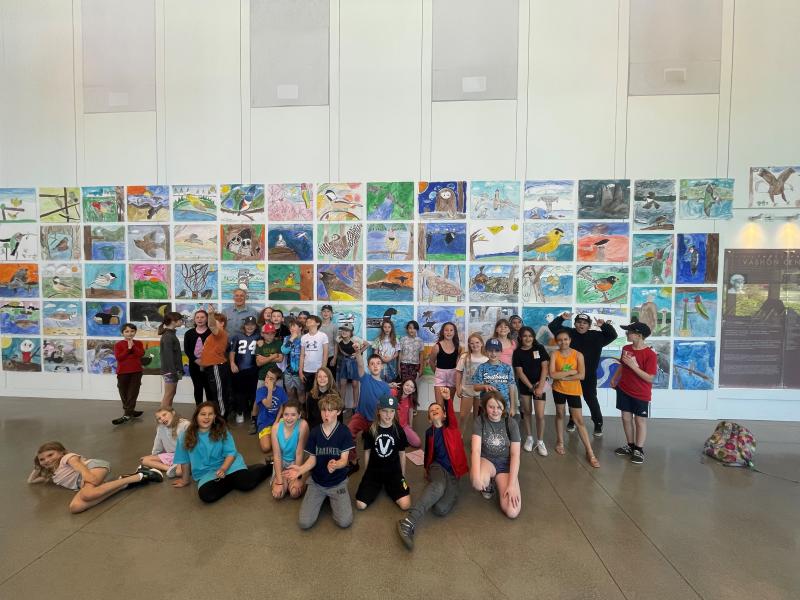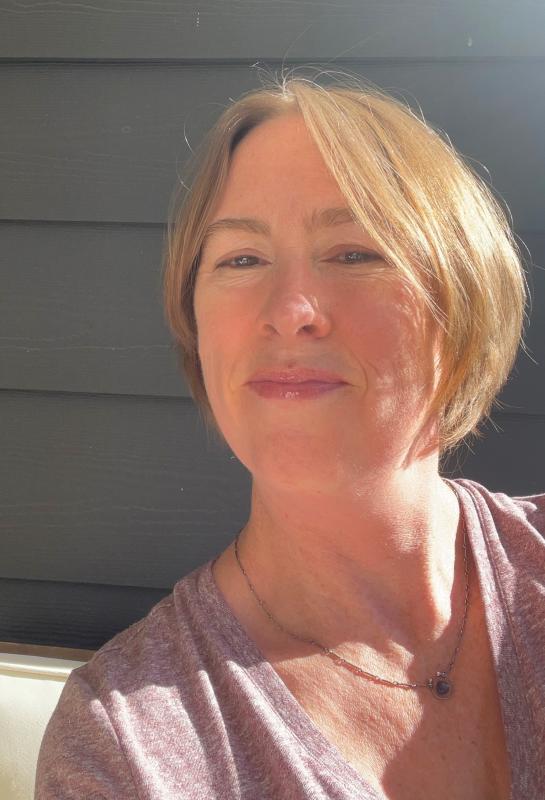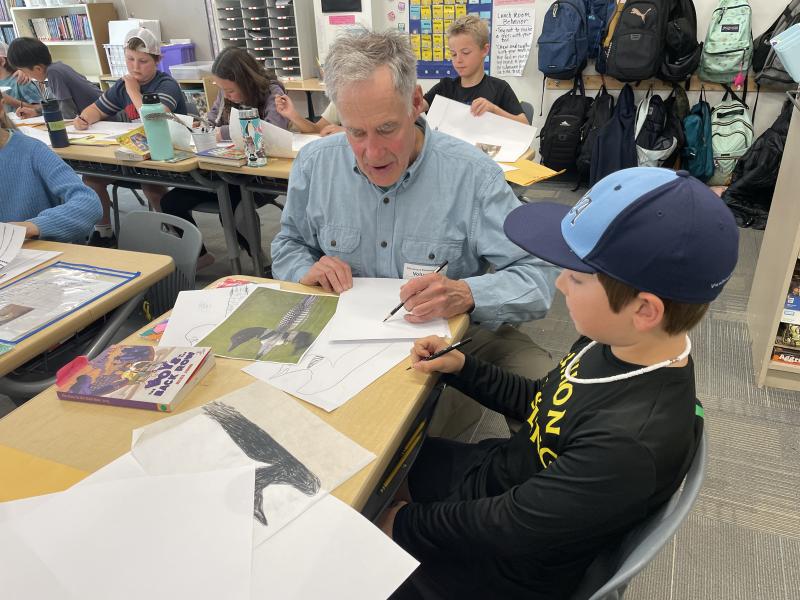Grant Spotlight: Vashon Center for the Arts

Chautauqua Elementary School’s 4th grade students gather with teaching artist Bruce Morser in front of their gallery show, Birds of Vashon. This show was a part of VCA’s First Friday gallery event and was open to the public for the month of June. Photo courtesy of Stephanie Johnson Blomgren, Vashon Center for the Arts
Originating from a grassroots movement by the residents of rural Vashon Island, Washington, Vashon Center for the Arts (VCA) began as a collective in 1949 and became a non-profit in 1966. Stephanie Johnson Blomgren, Vashon Artists in Schools (VAIS) program manager, said “While our island community had long fostered a love of the arts, until VCA, no organization was coordinating these efforts and the lack of performance space was limiting possibilities.” In 1977, a grant from the Comprehensive Employment and Training Act enabled the opening of an arts resource center, broadening VCA's artistic reach. VCA assumed management of the historic Oddfellows Hall and in 1985, purchased the building known today as the Blue Heron Education Center—the creative hub for the Vashon Center for Dance, various fundraisers, a literary arts program, jazz improvisation sessions, and numerous arts classes, ranging from ceramics to Suzuki violin lessons. The VCA campus includes not only the Blue Heron but also the Katherine L. White Hall, a world-class performance and learning space, a gallery showcasing exhibitions by local and regional artists, and a 3.5-acre wetlands restoration site in collaboration with the Vashon Nature Center.
In January 2024, VCA received an Arts Endowment grant to support the work of VAIS, a collaborative program with the Vashon Island School District that offers year-round K-12 classroom residencies led by professional artists across various artistic and expressive disciplines.
We spoke with Johnson Blomgren about the impact of the VAIS program, her advice for teachers who want to implement the arts in their lessons, and the importance of community arts programming for everyone.

Stephanie Johnson Blomgren. Photo courtesy of Johnson Blomgren, Vashon Center for the Arts
NEA: What sparked the creation of the VAIS program?
STEPHANIE JOHNSON BLOMGREN: VAIS began more than 35 years ago as a partnership between the Vashon Island School District and Vashon Center for the Arts as a means of supporting local artists, while also supporting and enhancing curriculum in the schools. The heart of VAIS is to invite teachers to share techniques and approaches to incorporating an art practice into the classroom. We do this through working partnerships between teaching artists and classroom teachers. Some projects are so successful that they become “legacy” residencies—repeated and refreshed over many seasons with new artists and artistic approaches.
NEA: Could you provide an overview of the program and what the goals are for the upcoming school year?
JOHNSON BLOMGREN: Broadly, the mission of VAIS remains the same year to year—to partner with professional regional artists for classroom-based residencies, public art projects, and teacher mentorships. Since COVID, we have also aimed to be open to need, however it surfaces during the school season. Sometimes that means bringing artist guest groups to classrooms or providing large-scale school-wide assemblies in our theater. This season, VAIS will continue to support expanding our residencies for middle and high school students with an eye toward increasing
access for all students with one-time engagements. With VCA’s support, we are also continuing to offer students free access to concerts and events at Vashon Center for the Arts, as well as offering talks that help teachers satisfy continuing education “clock hours.”
NEA: Can you give us a snapshot of a VAIS residency?
JOHNSON BLOMGREN: While VAIS does not have a set curriculum, sponsored residencies run anywhere from 10 to 40 hours of instruction, depending on the need. Artist Bruce Morser partners with our fourth-grade teaching team to bring a section of their Pacific Northwest birding unit to life through drawing and watercolor painting. Students begin by choosing and researching a bird, and from there, Bruce leads students through the process of seeing. Each incremental step—from translating a photo to a drawing, enlarging their creation, to finally painting and viewing the collective exhibit at the VCA Gallery—is revelatory. He asks students to take what occasionally feels like a big risk: don’t erase, keep drawing! And again, to look and really see what is there; not just what you think you see in a picture. What are the colors? What are the elements? What is the perspective? And what choices do you, as the artist, make in your work?
Seeing these works together in the VCA Gallery after final installation is a proud moment for students and families. Their show is given pride of place in the gallery for an entire month with our wonderful Vashon community able to turn out and honor the work of these fourth graders. It’s pretty special.

5th Grade students at Chautauqua Elementary School created “low tech, high magic” puppets for Adam Ende’s 2024 VAIS arts workshop complimenting their U.S. History unit. Each puppet was created out of cardboard, incorporating flexible elements with recycled materials like strips of bike tire innertube. Students used different types of ink and paint to decorate. When the puppets were ready, students performed their own creative plays inspired by historical events for family and friends. Photo courtesy of Stephanie Johnson Blomgren, Vashon Center for the Arts
NEA: Could you share a success story from the program?
JOHNSON BLOMGREN: One of my favorite stories from this season (and there were many) comes from a fifth-grade residency at Chautauqua Elementary School. Artist Adam Ende specializes in what he calls “low tech, high magic” puppetry through cardboard-built puppets. This was Adam’s second year running the project with Chautauqua’s fifth-grade teaching team. They worked to refine and perfect their model this year, inspired by United States history during the American Revolution. Students spent several weeks researching, reading stories about the Revolution, and then writing their own historically inspired plays.
After hours of work, including cardboard sets, students performed for their families and received great applause. Afterward, a parent reached out to Adam to share just how much that project meant, saying, “A giant thank you for the time you spent with my [student and their] classmates over many weeks, culminating in today’s puppet show at Chautauqua. [Their] excitement and creativity shined through on this project, but more importantly it was apparent how seriously [they] took the work, the responsibility [they] took to get things done, and the pride [they] had…from a successful performance. It’s a big deal to us because there are many times of struggle in the structured environment of school and the classroom—so a creative venture like this project meant a lot. Thank you!”
NEA: Serving a rural island community with about 11,000 residents, how does the organization ensure that its programming is accessible and inclusive for everyone, especially considering the geographic challenges of being accessible only by ferry?
JOHNSON BLOMGREN: Travel by ferry is a frequent hardship for community members, both economically and logistically. Though we have two sizeable metro areas to the north and south of the island, there are times when life on Vashon Island can feel a million miles away from access to the benefits of a city. VCA has worked to fill this need in myriad ways—everything from free cultural events, like our Jam in the Atrium jazz series, to showcasing local partner organizations, to the international artists in our Classical Piano series. We build our programming schedules to educate and lead by celebrating diversity, equity, and inclusivity with mindfulness. Our efforts make a difference not only in how our patrons interact in our local and neighboring communities, but in how we set the stage for our next generations.
Vashon Island has a high percentage of LGBTQIA+ families, a growing and dynamic Latinx culture, a large number of retired seniors, and patrons with a strikingly wide range of incomes, backgrounds, and interests. We work diligently to welcome and support arts experiences for every resident on the island, providing more than $70,000 in scholarships annually to our arts, dance, and music classes, organizing arts residencies in public school classrooms at no cost to the 1,200 students, and offering free tickets to youth and in-need families to most of our performances.

VAIS teaching artist Bruce Morser kneels down with a student to review and puzzle through design challenges during the 4th grade arts residency, Birds of Vashon, at Chautauqua Elementary on Vashon Island. Photo courtesy of Stephanie Johnson Blomgren, Vashon Center for the Arts
NEA: How has NEA funding helped support the work of the program?
JOHNSON BLOMGREN: The NEA’s support of VAIS and the projects we are able to sponsor within our community and school district is truly life-changing. Our small island is not immune to the challenges many communities face around educational funding. It is no secret that the arts are often at risk of being sidelined in the face of other needs. Our decades-strong partnership with Vashon Island School District, however, speaks to a legacy of trust—and our community works very hard to provide the seed money we need to support our classroom teachers. With the NEA’s considerable support, that seed of trust is amplified and boosted, district-wide. And those stories of success and joy in learning—inspiration, really, that travels with students through life—continue to build and make our community a more vibrant place to live.
NEA: If you had to give a teacher a few resources and a piece of advice to start off their toolkit of arts education for their classroom, what would that be?
JOHNSON BLOMGREN: Perhaps the best place a classroom teacher can begin an arts journey is by following their own curiosity—in that place of wonder or mystery around expression. Many VAIS arts residencies have started in that unassuming way. A teacher who loves sculpture or photography, for example, but isn’t sure how that dovetails into a math or science curriculum. Our VAIS teaching artists flourish in that space of creation, where passions and expertise meet surprise and delight in the classroom. And often, partnerships build, year after year, becoming essential and anticipated frameworks for learning.
For classroom teachers without the immediate resource of organizations like VCA and VAIS, a search for classroom connections could start in a number of places. The NEA’s own state search, https://www.arts.gov/impact/state-profiles, shares stories of area-specific programs where the arts enhance learning, provide inspiration, and demonstrate avenues to connect. The NEA’s partner organization, https://www.aep-arts.org/, is another resource focused on arts partnerships across the country. Local museums, galleries, performance groups, and companies often have an educational arm where touring groups and individual artists share their expertise with school districts. But begin with wonder and curiosity—you can’t go wrong sharing your own artful passion with emerging student-artists, eager for new ways of seeing through an arts lens of the world.

Before students can transfer their designs to a larger canvas, they sketch their designs several times. VAIS teaching artist Bruce Morser works with a student to consider what ways an artist can “see” a subject and what techniques to use to bring their subject to life. Photo courtesy of Stephanie Johnson Blomgren, Vashon Center for the Arts
NEA: What are some of the other ways in which the organization engages with the community?
JOHNSON BLOMGREN: Vashon is lucky to be home to a wide variety of important and vibrant organizations and VAIS has partnered with many of them over our 35 plus years of arts education in this community. Just a few recent examples include supporting a “pen pal” project with Vashon elders in the community (led by the school district’s third-grade cohort), partnering with a teaching artist to create a community-wide Vashon Pride Parade and Celebration, and an arts installation partnership with fifth-grade students in the VCA Heron Meadow, alongside Vashon Nature Center.
NEA: Finish this sentence. Arts education is essential because…
JOHNSON BLOMGREN: . . . it ignites a fresh passion for learning in students and teachers—building not only resiliency, but a creative spark that will follow and inspire them all through life.




